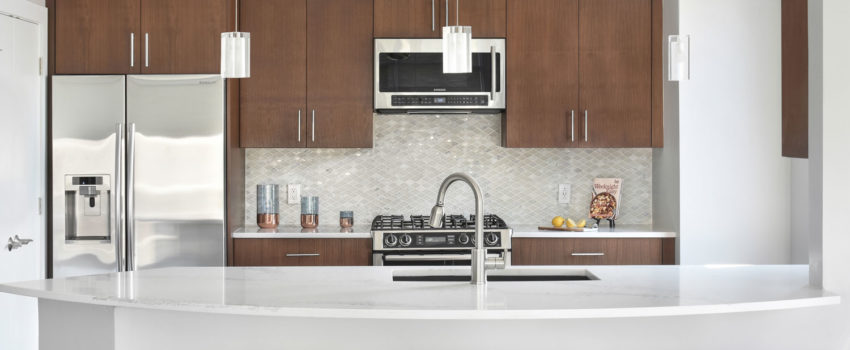
Next to the living room, the kitchen is often considered the heart of the home – it’s where you can whip up scrumptious meals, entertain guests, and spend quality time with your loved ones.
As such, understanding how to design a beautiful and functional kitchen is essential for any homeowner. In order to help you achieve your dream space, we’ve compiled 15 expert kitchen design tips to get you started.
1. Optimize Your Layout
A well-designed kitchen layout maximizes efficiency and functionality, ensuring your kitchen works with you, not against you. Cooking and cleaning can easily be streamlined by following the classic “work triangle” layout, which positions the sink, stove and fridge in a triangular formation for optimal flow to promote easy movement between tasks.
Your kitchen can have multiple work triangles based on your needs. For example, you can have a primary zone for food prep, a secondary zone for cooking and baking and a tertiary area for circulation. This layout ensures traffic flows smoothly during food prep.
2. Consider Your Storage Needs
Storage is often an afterthought in kitchen design, but it can make or break the functionality of your space. Finding what you need quickly and easily will make cooking much more efficient and enjoyable.
Consider dividing your kitchen into zones for different functions, then plan how much storage and what kind of storage you need for each zone. This ensures that everything has a designated place and that cooking is a less chaotic experience.
3. Incorporate Smart Storage Solutions
In addition to traditional storage options like cabinets and drawers, consider incorporating smart storage solutions into your kitchen design. This could include pull-out shelves, vertical dividers in cabinets, or a built-in pantry with customizable shelving.
Utilizing every nook and cranny of your kitchen is key to maintaining an organized and clutter-free space.
4. Don’t Skimp on Lighting
Lighting is crucial in any room, but it plays an even more significant role in the kitchen, where you handle dangerous tools like knives and fire. Dimmable ceiling downlights provide bright task lighting, while pendants over the island or sink area add a cozy ambiance. Undercabinet lighting is also popular for illuminating countertops and creating a warm glow.
If you have the opportunity to add windows or skylights, take it. Natural light makes small spaces feel larger and improves the overall mood.
5. Choose Durable Materials
Kitchens are high-traffic areas, so durability is key when selecting materials for finishes like countertops, backsplashes, and flooring. Quartz countertops are scratch-resistant and come in various colors and design options. Similarly, porcelain tiles are durable and come in multiple styles to suit your aesthetic.
For flooring, consider ceramic or vinyl tile for easy maintenance. If you prefer the look of wood, opt for laminate or luxury vinyl planks that mimic the appearance of hardwood without the high maintenance.
6. Add a Focal Point
Find a feature you love and make it the focal point of your kitchen. Whether it’s a bold backsplash, statement light fixture or unique island, incorporating a focal point adds interest and personality to the space. Once you’ve identified your focal point, ensure the rest of your design elements complement rather than compete with it.
7. Account for Traffic Flow
The kitchen is a hub for activity and traffic, so it’s essential to consider the flow of movement when designing your space. Ensure enough space between countertops and appliances for multiple people to move around comfortably. You may also want to avoid creating a bottleneck by having an open pathway from one room to another.
As a rule of thumb, kitchen paths should be at least 36 inches wide, with cooking zone aisles being 42 inches wide for one cook and 48 inches wide for two cooks.
8. Design a Multifunctional Kitchen
Over the years, kitchens have evolved from rooms used solely for cooking to multifunctional spaces where people gather, work, and entertain. One of the best kitchen design tips for creating a versatile space is incorporating an island with seating. Depending on your needs, islands can serve as a prep area, dining table, or even a home office.
You can also incorporate multifunctional appliances, such as a built-in microwave that doubles as a convection oven or a refrigerator, with smart technology that allows you to access recipes and calendars.
Room dividers, such as a sliding barn door or open shelving, are also excellent for cordoning off areas to maintain privacy or extend your kitchen for parties or events.
9. Incorporate Sufficient Countertop Space
The amount of counter space depends solely on preference and needs, but it’s always better to have more than less. Having ample countertop space allows for easy food prep, serving, and storage of everyday appliances like a toaster or coffee maker. It also makes cleaning up after meals much more manageable.
If you need more counter space, consider adding a floating shelf or installing a pull-out cutting board in your design. A portable island can also provide additional workspace when needed.
10. Organize the Range Area
The stove and surrounding area are high-traffic zones in the kitchen, so it’s important to keep this space organized and functional. Keep pots and pans within reach by hanging them on a pot rack or installing deep drawers for easy access.
Use dividers in your drawers to keep utensils organized, and consider adding a spice rack or shelf above the range for quick access to frequently used spices. S-hooks are also handy for hanging cooking utensils or measuring cups from the side of your range hood.
Additionally, incorporate a hood above your stove to keep cooking odors and smoke at bay. Hoods come in various styles and sizes, so choose one that complements your kitchen design.
11. Add Enough Electrical Outlets
Today’s modern kitchens require significant electricity to power various appliances and devices. Ensure you have enough outlets throughout your kitchen, including ones designated for small appliances on the countertop.
Don’t forget about convenience outlets, such as those under cabinets or above an island, for plugging in accessories like blenders and mixers. Also, consider adding USB outlets for charging phones and tablets.
If your kitchen layout doesn’t allow for many outlets, extension cords and power strips can be used temporarily but should not be a long-term solution.
12. Keep Safety in Mind
Safety should always be a top priority when designing your kitchen. This includes having proper ventilation, installing a fire extinguisher, and keeping dangerous tools and chemicals out of reach of children and pets.
Consider child-proofing cabinets with locks or placing hazardous items on high shelves. You may also want to invest in slip-resistant flooring, especially if you have young children or are prone to spills. Kitchens can be hazardous, so taking precautions and designing with safety in mind can prevent accidents and injuries.
13. Utilize the Power of Color
Color is a powerful tool in interior design, and the kitchen is no exception. While it’s important to choose colors you enjoy, remember how different shades can impact the mood of the space and visually expand or shrink the room.
For a bright and spacious feel, opt for light colors like white or pale gray. To add warmth and coziness, choose deep, rich tones like navy blue or forest green. You can also incorporate pops of bold color through accessories or a statement piece, such as a colorful backsplash or island.
If you have a small kitchen, avoid using dark colors on the walls and instead opt for lighter shades to create an illusion of space. Large windows will also bring in natural light and make the room more inviting.
14. Don’t Be Afraid to Mix and Match Styles
Gone are the days of strictly adhering to one design style in a home. Mixing and matching different styles in your kitchen adds depth and character to the space. For example, you could mix modern cabinetry with vintage-inspired hardware or incorporate rustic elements into a contemporary kitchen.
Just make sure to maintain a cohesive look by incorporating complementary colors, textures, and finishes throughout the space.
15. Keep an Eye on Trends, But Stick to What You Love
Trends come and go, but your personal style should always be the main focus of any design project. While it’s essential to stay up-to-date on current trends for inspiration, don’t feel pressured to incorporate them all into your kitchen design.
Stick to what you love and what works for your lifestyle, whether that’s a classic, timeless look or something more trendy and bold.
Build Your Dream Kitchen With Help From the Pros
If you know what you want in your dream kitchen but need help to bring it all together, consider working with a professional designer. They can help you create a functional and stylish space that meets all your needs and reflects your style.
Whether you’re looking to do a complete kitchen remodel or need help with layout and design, VRA Interiors can help. We offer a range of design services to help you create beautiful, functional spaces that suit your requirements.
Our virtual design process provides a streamlined, cost-effective way to design your space, encouraging greater client involvement and faster project completion. Contact us today to learn more, or check out our resources for some great kitchen design tips.


